
Three months after the coronavirus emerged in China, it has quickly spread to nearly half a million people across the globe, killing more than 22,000 people and bringing the world economy to a near-grinding halt.
Some scientists estimate that millions will ultimately die before COVID-19 runs its course. There’s a lot that infectious disease specialists and scientists still don’t know about the virus. Exactly how deadly and contagious COVID-19 is, is still a matter of debate.
We break down what we know about the virus and how it compares with some of history’s deadliest pandemics and diseases. First, you’ll have to bone up on a bit of epidemiology.
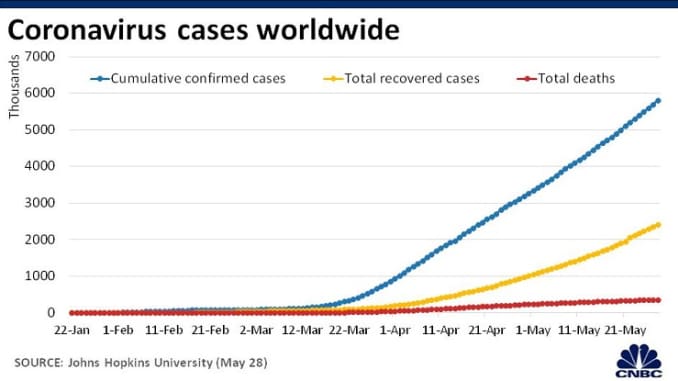
COVID-19
R naught (a mathematical term that indicates how contagious an infectious disease is): 2
Mortality rate: 4.5% (this number is in flux)
World population: 7.8 billion
The mortality rate
The mortality rate is an important metric for epidemiologists because it helps determine just how many people will likely die from a particular disease and its potential impact on health systems, said Isaac Bogoch, a University of Toronto infectious disease specialist.
The mortality rate is basically the number of deaths divided by the number of infections. It’s also called the death rate or case fatality rate. At the beginning of an outbreak, it can be a moving target as more people are tested and an illness like COVID-19 travels to different parts of the world where the mortality rate can widely vary.
Looking at just the number of deaths over the number of cases reported “is only a snapshot,” Maria Van Kerkhove, head of the World Health Organization’s emerging diseases and zoonosis unit, told reporters last week.
A variety of factors affects the mortality rate: geography, the quality of health care, age of the population, life style and underlying conditions. In China, the mortality rate for CV-19 has been 4%. In Italy, it’s about 10%. In Iran, it’s about 7.6%. In Germany, it’s less than 1% and in the U.S., where the outbreak is just getting underway, it’s about 1.5%.

GP: Coronavirus Outbreak Continues In Italy
Red Cross staff wearing a protective containment suit return to the Red Cross headquarters after transporting a Covid 19 patient to a hospital in Turin on March 25, 2020 in Turin, Italy. The Italian government continues to enforce the nationwide lockdown measures to control the spread of COVID-19.
Stefano Guidi | Getty Images
The mortality rate generally drops as testing rises and more patients are identified. But epidemiologists caution that the reverse can be true as U.S. hospitals get inundated and run out of necessary equipment, like ventilators, to treat patients who might have otherwise been saved. They also say it takes weeks for the virus to infiltrate a community and several more before people are sick enough to die. So it will be several months before the true mortality rate can be quantified in the U.S. or elsewhere.
Scientists still don’t know the true extent of the outbreak, so “we don’t know the precise number of those who will die out of those who are infected,” Kerkhove said.
The first estimate of the mortality rate for COVID-19 was roughly 2.3%, according to the WHO. As the death tally rose across the globe, so did the mortality rate, which the WHO revised on March 3 to 3.4%, meaning 3.4% of the population with confirmed infections died. Many scientists think, or are at least hopeful, that the mortality rate will fall as more people are tested and mild cases that have previously gone undetected are identified.
President Donald Trump is in that camp, calling the WHO’s revised estimate of 3.4% a “false number”and that he had a hunch the true mortality rate was well under 1%.
That hasn’t panned out so far, even as much of Europe, parts of Asia and the U.S. dramatically ramp up testing. More cases are being identified, to be sure, but people have been dying at a faster rate.
The current global mortality rate now stands at around 4.5%, which is calculated by dividing the 22,295 deaths by the 495,086 confirmed cases as of Thursday afternoon, according to Johns Hopkins University data. Most scientists agree the mortality rate will fall by the time the disease runs its course.
The ‘R naught’
Scientists also assess the so-called R naught of the disease, a mathematical equation that shows how many people will get sick from each infected person. Just like the mortality rate, the R naught will fluctuate over time as scientists gather more data, and it can vary depending on where someone lives.
Estimates of the R naught for COVID-19 have ranged from 1.4 to about 5. The WHO has estimated the R naught of COVID-19 to be around 1.95 and other estimates from researchers following the outbreak put it around 2.2, meaning about two people will catch the virus from every person who already has it.
The R naught can also be heavily reduced, depending on what a nation does to contain the virus, which is why state and local officials are scrambling across the U.S. to close businesses and keep people indoors. China last week reported its first day with zero new cases after placing much of the nation under lockdown for nearly two months. The R naught can also dramatically increase if a country does nothing.
“If the R naught is higher than 1, it will spread and it will be contagious,” Yanzhong Huang, a public health researcher at the Council on Foreign Relations and director of the Center for Global Health Studies at Seton Hall University, said in a phone interview with CNBC last month. “Without any containment measures, technically it can spread to the whole population.”
The number of CV-19 cases and deaths changes by the hour. Some scientists predict half the world’s population will eventually get it.
Here’s how COVID-19 stacks up against other pandemics and serious outbreaks. (The R naught and mortality rates figures are from a March 9 report on deadly outbreaks by financial research firm Morningstar unless otherwise noted.)
Seasonal flu
R naught: 1.3
Mortality rate: 0.1%
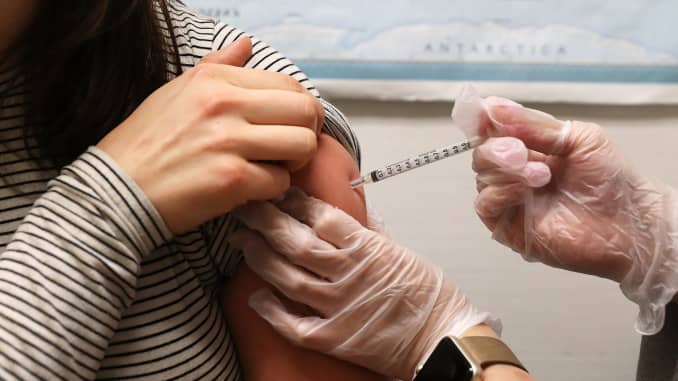
GS: Woman receives a flu shot 180122
A woman receives a flu shot at a Walgreens pharmacy in San Francisco.
Getty Images
Many have compared the COVID-19 outbreak to influenza, also known as the common flu, another respiratory illness that has symptoms similar to CV-19.
So far, COVID-19 is proving to be more infectious with an R naught of around 2 than the seasonal flu, which has an R naught of 1.3 and infects up to 49 million Americans each year. Based on the WHO’s most recent mortality rate of 3.4%, the COVID-19 outbreak is shaping up to be at least 34 times deadlier than the flu, which has a mortality rate of about 0.1% and kills 290,000 to 650,000 people per year across the globe. If the current mortality for CV-19 rate holds at 4.5%, it would make this coronavirus 45 times deadlier than the flu.
2009 H1N1
R naught: 1.5
Mortality rate: 0.02%
World population in 2009: 6.79 billion

H1N1 strain of the swine flu virus.
The H1N1 swine flu emerged in Mexico in April 2009, infecting 60.8 million people in the United States alone and at least 700 million worldwide. An estimated 151,700 to 575,400 people died from the virus across the globe, according to the Centers for Disease Control and Prevention. Epidemiologists estimate it had an R naught of 1.5, making it less infectious than COVID-19.
The mortality rate is estimated at around 0.02% and ”[H1N1] ended up being a lot milder overall than we once feared, but it hit certain subgroups pretty hard,” former FDA Commissioner Scott Gottlieb said.
1957 flu pandemic
R naught: 1.7
Mortality rate: 0.6%
World population: 2.87 billion

The H2N2 virus pandemic was first reported in Singapore in February 1957. It killed an estimated 1.1 million people worldwide and 116,000 in the United States. COVID-19′s R naught of around 2 is in line with the H2N2 virus, but the current virus appears to have a far deadlier potential.
1918 flu pandemic
R naught: about 1.8
Mortality rate: 2.5%
World population: 1.8 billion (est.)

GP: 1918 Flu Pandemic Warehouses that were converted to keep the infected people quarantined.
The 1918 flu was one of the most horrific pandemics of the 20th century, hitting those ages 20 to 40 especially hard, according to WHO. COVID-19′s R naught of 2 is slightly more infectious than the 1918 flu.
The 1918 flu, which was known as the Spanish flu, didn’t actually originate in Spain. It had a mortality rate of 2.5% and killed more people — 30 million to 50 million — than the 20 million who died in World War I. If the 4.5% mortality rate of COVID-19 drops, it won’t be as bad as the 1918 flu. If it continues on its current trajectory, it will be almost twice as deadly.
SARS
R naught: 2 to 5
Mortality rate: 10%
World population in 2003: 6.38 billion
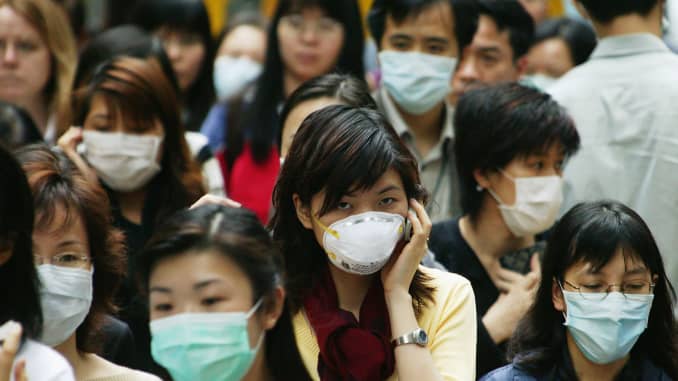
GP: Hong Kong Citizens Cope With SARS Virus
Severe acute respiratory syndrome, or SARS, is a coronavirus that emerged in the Guangdong province of southern China in November 2002 but didn’t spread wide enough to become a pandemic. Unlike COVID-19, SARS was generally transmitted only after people started showing symptoms, which helped contain the outbreak. SARS, which infected 8,098 people worldwide by July 2003, is believed to have an R naught of 2 to 5. The mortality rate for SARS, which killed nearly 800 people, is estimated at 10%, according to the CDC.
MERS
R naught: 0.5
Mortality rate: 35%
World population in 2012: 7.13 billion
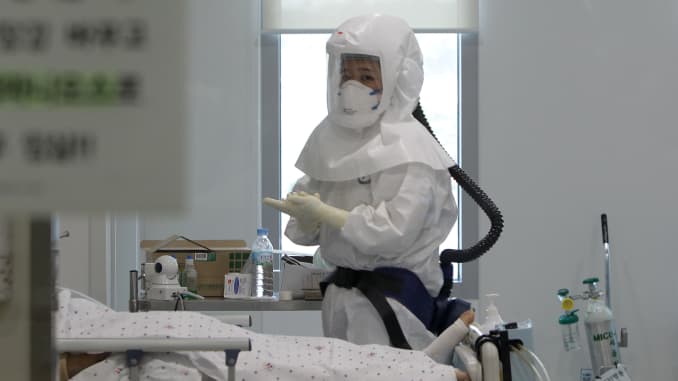
GP: South Korea Continues To Handle MERS Outbreak
A health worker cares for a MERS patient at Seoul Medical Center, South Korea, June 10, 2015.
MERS, which stands for Middle East respiratory syndrome, emerged in Saudi Arabia in 2012 and infected at least 2,494 people across 27 countries, including 858 deaths, according to the WHO. With an R naught of 0.5, MERS is much less infectious than COVID-19′s R naught of 2. It’s much deadlier, however, with a mortality rate of 35%.
Measles
R naught: 12 to 18
Mortality rate: unclear
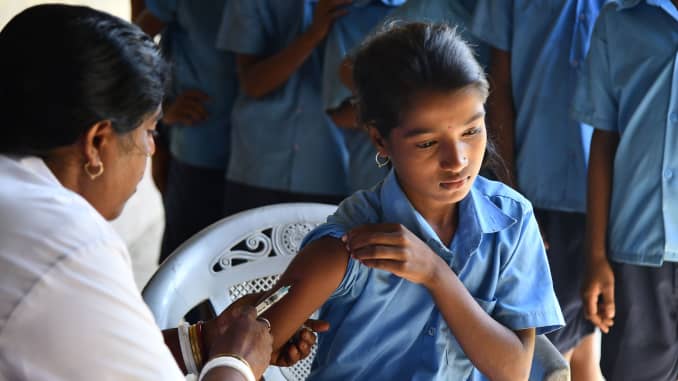
GP: INDIA-HEALTH-CHILDREN
An Indian health worker administers a measles and rubella vaccine to a student at a government school at Hatibhangi village in Morigoan in Assam state on September 4, 2018.
Measles is one of the most contagious viruses in the world with an R naught of 12 to 18, according to a paper published in 2017 in the peer-reviewed journal The Lancet. Determining the mortality rate is difficult.
Before a vaccine was developed in the early 1960s, most cases went unreported, and the CDC estimates up to 4 million people in the U.S. actually caught measles every year, killing 400 to 500 people annually. In 2009, worldwide measles vaccination coverage reached 82%, and from 2000 to 2008, the number of deaths from measles dropped from 733,000 to 164,000, according to the WHO. Measles is a seasonal disease, meaning it comes back every year.
Ebola
R naught: about 2
Mortality rate: exceeds 50%
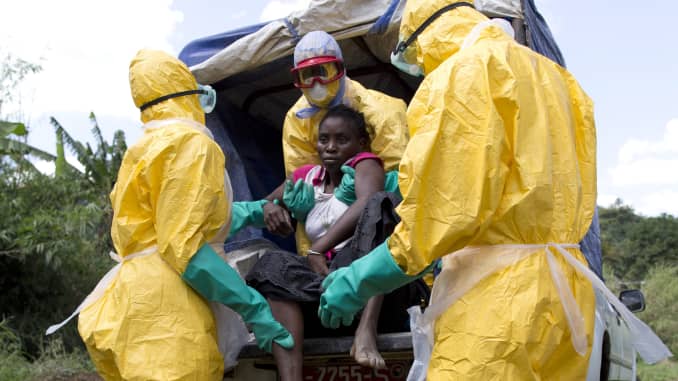
Premium: Ebola health workers near Macenta Guinea 141121
Health workers wearing protective suits assist a patient suspected of having Ebola on their way to an Ebola treatment centre run by the French Red Cross in Patrice near Macenta on November 21, 2014.
The Ebola virus disease, formerly known as Ebola hemorrhagic fever, was identified in 1976 in the Democratic Republic of Congo near the Ebola River. It doesn’t come back every year, but it has periodically recurred over the last 44 years. Like the current coronavirus, the virus virus has an R naught of 2, according to a report published in 2014. But Ebola is far deadlier, killing more than half the number of people who are infected.
Ebola has spread to more than 31,000 people — mostly in Africa, not including the current outbreak in the Democratic Republic of Congo, according to WHO data. It has killed more than 12,900 people, also excluding the current outbreak.
VIDEO08:23
How US coronavirus travel restrictions could affect airline, hospitality industries
Containing the outbreak
The death and infection rates for COVID-19 are not set in stone, global health officials say, reminding the public and world leaders that a coordinated response can lower both.
“We cannot say this loudly enough or clearly enough or often enough: All countries can still change the course of this pandemic,” WHO Director-General Dr. Tedros Adhanom Ghebreyesus said on March 11, when the agency declared the COVID-19 pandemic.
In some countries such as Italy, where there are more than 74,000 cases, the country has been under lockdown.
In the U.S., Trump has imposed travel bans for much of Europe and Asia. Roughly half of the nation is under some sort of quarantine for the foreseeable future. The U.S. outbreak is accelerating with hot spots in California, Washington state and New York, which has more than half of the 69,000 U.S. cases. Trump’s coronavirus task force is advising anyone who travels through New York to self-isolate for two weeks and monitor their symptoms if they leave the area.
Dr. Anthony Fauci, director of the National Institute of Allergy and Infectious Diseases, is also asking healthy, young individuals to stay indoors, saying slowing the outbreak will not work without them.
“When I was young, I thought I was invulnerable. We are asking young people to help with the mitigation strategy by staying out the bars, staying out of the restaurants,” Fauci said at a White House briefing on March 17 — St. Patrick’s Day. “We can’t do this without the young people cooperating.”
While governments and the public attempt to slow the spread, health officials and pharmaceutical companies are quickly working to produce a vaccine, with the first human clinical trial beginning last week. Hopes of getting a vaccine to market are high, but doctors are setting expectations low for how quickly it can happen.
It will take a minimum of 12 to 18 months for a vaccine to make it to the market, U.S. officials say. In the meantime, they are fast tracking clinical trials on drugs that show promise in treating the virus, telling people to stay indoors, keep their distance and wash their hands often.
